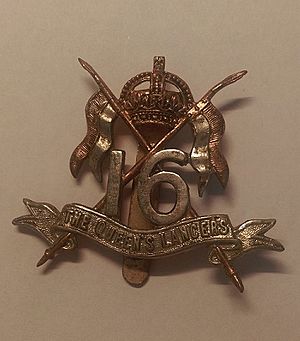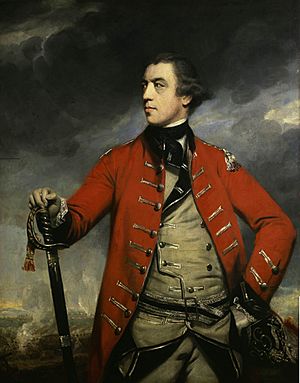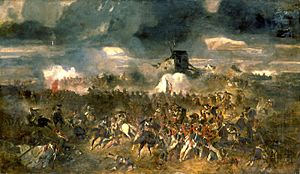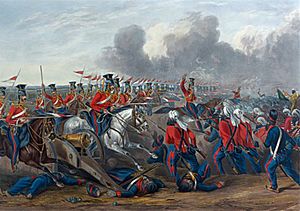16th The Queen's Lancers facts for kids
Quick facts for kids 16th The Queen's Lancers |
|
|---|---|

Badge of 16th The Queen's Lancers
|
|
| Active | 1759–1922 |
| Country | |
| Branch | |
| Type | Line Cavalry |
| Size | Regiment |
| Nickname(s) | "The Scarlet Lancers" |
| Motto(s) | Aut cursu, aut cominus armis (Either in the charge or in hand-to-hand combat) |
| March | Quick: The English Patrol Slow: The 16th Lancers |
| Anniversaries | Aliwal (28 January) |
| Commanders | |
| Notable commanders |
General John Burgoyne Field Marshal William Harcourt, 3rd Earl Harcourt |
The 16th The Queen's Lancers was a famous cavalry regiment in the British Army. It was first formed in 1759. For over 200 years, this regiment served in many wars around the world. In 1922, it joined with another regiment, the 5th Royal Irish Lancers. Together, they became the 16th/5th Lancers.
Contents
A Look Back: The Regiment's History
Early Battles and Adventures

The regiment began in 1759. It was created by Colonel John Burgoyne and was called the 16th Regiment of (Light) Dragoons. Dragoons were soldiers who rode horses but could also fight on foot. This regiment was also known as "Burgoyne's Light Horse."
They were very active during the Seven Years' War. In April 1761, they helped capture the French base at Belle Île. They also played a big part in British wins against the Spanish. This happened at the Battle of Valencia de Alcántara in August 1762 and the Battle of Vila Velha in October 1762.
In 1766, the regiment was renamed after Queen Charlotte. It became the 2nd (or The Queen's) Regiment of (Light) Dragoons. But the old numbering system came back quickly. By 1769, it was the 16th (The Queen's) Regiment of (Light) Dragoons again.
The regiment then went to New York in October 1776. They fought in the American Revolutionary War. They were involved in battles like Battle of White Plains (October 1776), Battle of Brandywine (September 1777), and Battle of Germantown (October 1777). They also saw action at Battle of Crooked Billet (May 1778), Battle of Barren Hill (May 1778), and Battle of Monmouth (June 1778). The regiment returned to England in spring 1779.
Later, in April 1793, they went to Ostend to fight in the Flanders Campaign. They were at the siege of Valenciennes (June 1793) and the siege of Dunkirk (August 1793). They also fought in the Battle of Beaumont (April 1794) and the Battle of Willems (May 1794). They came back to England in February 1796.
Fighting in the Napoleonic Wars

In April 1809, the regiment went to Lisbon to help Sir Arthur Wellesley's army in Spain and Portugal. This was during the Peninsular War. They fought in many important battles. These included the Second Battle of Porto (May 1809), Battle of Talavera (July 1809), and the siege of Ciudad Rodrigo (April 1810).
They also saw action at the Battle of Bussaco (September 1810), Battle of Sabugal (April 1811), and Battle of Fuentes de Oñoro (May 1811). Later, they fought at the Battle of Salamanca (July 1812) and the siege of Burgos (September 1812). They were part of the big victory at the Battle of Vitoria in June 1813.
After moving into France, they fought at the Battle of Nivelle (November 1813) and the Battle of the Nive (December 1813). They returned home in July 1814.
The regiment then took part in the Hundred Days campaign. They landed at Ostend in May 1815. They made a brave charge with John Vandeleur's Cavalry Brigade at the famous Battle of Waterloo in June 1815. Their commander, Lieutenant-colonel James Hay, was badly hurt. The 16th was the only British cavalry regiment to serve through the entire Peninsular War and at Waterloo.
The Victorian Era and Beyond

In September 1816, the regiment changed its style of fighting. They became a lancer regiment. This meant they used long spears called lances in battle. Their new name was the 16th (The Queen's) Regiment of (Light) Dragoons (Lancers).
They were sent to India in 1822. There, they used their lances against the Marathas at the siege of Bharatpur in January 1826. They also fought in the First Anglo-Afghan War at the capture of Ghuznee in July 1839. In December 1843, they were at the Battle of Maharajpore during the Gwalior campaign.
A very famous moment for them was the Battle of Aliwal in January 1846. Here, the regiment charged and scattered a group of Sikhs ten times their size! They also fought at the Battle of Sobraon in February 1846 during the First Anglo-Sikh War. In 1861, their name was shortened to the 16th (The Queen's) Lancers. They served in India two more times, from 1865 to 1876 and from 1890 to 1899.
The 20th Century and World War I
In January 1900, the regiment landed in Cape Colony to fight in the Second Boer War. They helped in the relief of Kimberley in February 1900.
When the First World War began, the regiment was at The Curragh. In August 1914, they arrived in France as part of the 3rd Cavalry Brigade. This brigade was in the 1st Cavalry Division. They served on the Western Front.
In 1921, the regiment was officially renamed the 16th The Queen's Lancers. The next year, in 1922, it joined with the 5th Royal Irish Lancers. This created a new regiment called the 16th/5th Lancers.
Regimental Museum
You can learn more about the regiment at The Royal Lancers and Nottinghamshire Yeomanry Museum. This museum is located at Thoresby Hall in Nottinghamshire.
Uniform and Insignia
The regiment's collar badge had the number 16 above a scroll that said "Queen's Lancers." This was placed over two crossed lances and topped with a crown. The lancer cap they wore for formal events showed their battle honours and regimental number in silver.
When they first started as the 16th Light Dragoons, they wore the usual red uniform for cavalry. It had black, then royal blue, details. In 1784, their red coat was changed to a dark blue jacket.
From 1816 to 1832, they wore a dark blue lancer uniform. But in December 1832, all lancer regiments were told to wear a scarlet (bright red) jacket. This was to make red the main color for the national military. However, in 1840, light cavalry units were asked to go back to blue uniforms.
Sir John Vandeleur asked if the 16th could keep their scarlet jackets. His request was granted on March 2, 1841. This meant the 16th Lancers were the only lancer regiment to wear scarlet. They kept this unique scarlet uniform with a dark blue chest piece for formal dress until 1914.
Battle Honours: A List of Victories
Battle honours are special awards given for bravery and success in battles. Here are some of the battles the regiment was recognized for:
- Early Wars: Beaumont, Willems, Talavera, Fuentes d'Onor, Salamanca, Vittoria, Nive, Peninsula, Waterloo, Bhurtpore, Ghuznee 1839, Afghanistan 1839, Maharajpore, Aliwal, Sobraon, Relief of Kimberley, Paardeberg, South Africa 1900–02.
- The Great War (World War I): Mons, Le Cateau, Retreat from Mons, Marne 1914, Aisne 1914, Messines 1914, Armentières 1914, Ypres 1914 '15, Gheluvelt, St. Julien, Bellewaarde, Arras 1917, Scarpe 1917, Cambrai 1917, Somme 1918, Amiens, Hindenburg Line, Canal du Nord, Pursuit to Mons, France and Flanders 1914–18.
Victoria Cross Hero
The Victoria Cross is the highest award for bravery in the British military.
- Lieutenant Alexander Fincastle received this award during the Tirah Campaign on August 17, 1897.
Images for kids
-
Colonel John Burgoyne, founder of the regiment, by Joshua Reynolds, c.1766
-
Charge of the 16th Lancers at the Battle of Aliwal, January 1846







